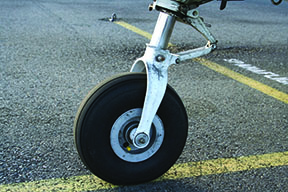I have been flying since 1971 and I enjoy reading the material from your magazine. I usually do not chime in with a response to an article, but this time I have to make an exception.

288
In reading the November 2012 article, “Flying The Nosewheel,” I agree with most everything written. I definitely got the message you think it is imperative to use full back pressure on the yoke during the taxi and early takeoff run, with exceptions for gusty and high wind conditions. But not all nose-gear aircraft are alike.
I have over 5000 hours in my Cardinal and if I did that, the nosewheel would almost be leaving the ground. The stabilator on the Cardinal combined with a rather long fuselage makes for very effective pitch control.
Which brings up another very important point: Most nosewheel aircraft have a centering mechanism designed into the nose gear that, when nearly fully extended, locks the nose in a straight alignment. This, of course, is to guarantee the next time you land, the nosewheel is pointed straight ahead and not cocked, which would steer you into the bushes. Nowhere in your article was this mentioned. Taxiing around always with full up pitch control could activate this lock, making the airplane steer like a bulldozer.
I have one other thought on nosewheel steering vs. differential braking. As I said, I fly a Cardinal a lot, and also a Caravan. I can turn either of these aircraft very tightly. I know that some nosewheel steering aircraft turn much wider; a Mooney comes to mind.
I definitely agree with your analogy on pitch control and landing. It comes with lots of practice, to make instinctive pressure inputs. Finally, on some airplanes with nosewheel-shimmy issues, I have found that more nose-down pressure, not less, can reduce the shimmy’s intensity.
Jerry Hamm
Via e-mail
Activity Reporting
With regard to November’s editorial, “Laugh Test,” and from a statistical standpoint, why could not the FAA provide all mechanics and repair stations with prepaid postcards? At each annual inspection, the mechanic would write in the tail number, the date and tach/Hobbs time at the prior annual inspection and the date and Hobbs/tach time at the current inspection.
The FAA would remove the tail number from its public records and replace it with make and model of the aircraft. No privacy invasion. The result would be data on hours flown by aircraft type with, say, a 90-percent level of accuracy instead of the continual WAG for hours flown.
Herb Rosenthal
Bethesda, Md.
That would be one way to do it, and is pretty much how we recall the FAA collected activity data several years ago. But we’re simply not aware of any huge problems with current methods, leaving us to wonder why the agency needs to change what it’s doing. We’re willing to be educated, of course.
More On Humidity
Using Donald Moen’s approach of knowing temperature, altitude and density altitude (Unicom, November 2012) doesn’t yield an accurate estimate of humidity, though his ideal gas law explanation is correct. The reason is hydrodynamics: The same density altitude at the same actual altitude and temperature can yield various humidity levels, and a resulting available horsepower range.

288
For example, when considering an irrigated windward valley, such as California’s San Joaquin, the more-humid windward side would experience reduced density (increased DA). The arid leeward side of the Sierra Nevada range may have increased density altitude from a Bernoulli-like pressure reduction effect from mountain winds with dryer air.
Scott Murray
Via e-mail




